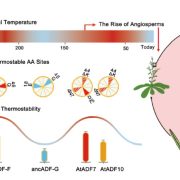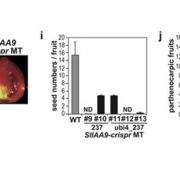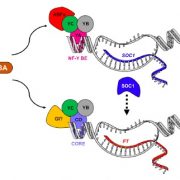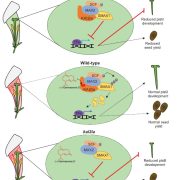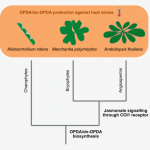Allelic mutations in the Ripening-inhibitor (RIN) locus generate extensive variation in tomato ripening ($) (Plant Physiol)
 Ripened fruits attract animals to eat and disperse seeds, allowing propagation. Slowing down the fruit ripening process is often used commercially to decrease damage during transport and extend shelf life. Molecular (increased pigment, aroma, and flavor) and physiological (softened flesh) changes of fruit ripening are highly synchronized, and RIPENING INHIBITOR (RIN) is one of the transcription factors regulating the process. Ito et al. used CRISPR/Cas9 to systematically generate and characterize rin mutants, including a previously-identified non-ripening mutant (rin), knockout mutants (KO), and mutants lacking the activator domain (rinG2). KO showed exacerbated flesh softening whereas rinG2 flesh remained unchanged along with high levels of carotenoid accumulation. The phenotypic disparities between rin mutants prompted the hypothesis that “RIN is not only a ripening activator, but also acts as a repressor of over-softening.” The study proposes a dual regulatory model involving RIN and ethylene in regulating fruit ripening-related genes, and provides an applicable strategy to tune activities of transcription factors. Further, the KO and rinG2 mutations could be adapted for enhances in fruit production. (Summary by Yun-Ting Kao) Plant Physiol. 10.1104/pp.20.00020
Ripened fruits attract animals to eat and disperse seeds, allowing propagation. Slowing down the fruit ripening process is often used commercially to decrease damage during transport and extend shelf life. Molecular (increased pigment, aroma, and flavor) and physiological (softened flesh) changes of fruit ripening are highly synchronized, and RIPENING INHIBITOR (RIN) is one of the transcription factors regulating the process. Ito et al. used CRISPR/Cas9 to systematically generate and characterize rin mutants, including a previously-identified non-ripening mutant (rin), knockout mutants (KO), and mutants lacking the activator domain (rinG2). KO showed exacerbated flesh softening whereas rinG2 flesh remained unchanged along with high levels of carotenoid accumulation. The phenotypic disparities between rin mutants prompted the hypothesis that “RIN is not only a ripening activator, but also acts as a repressor of over-softening.” The study proposes a dual regulatory model involving RIN and ethylene in regulating fruit ripening-related genes, and provides an applicable strategy to tune activities of transcription factors. Further, the KO and rinG2 mutations could be adapted for enhances in fruit production. (Summary by Yun-Ting Kao) Plant Physiol. 10.1104/pp.20.00020
[altmetric doi=”10.1104/pp.20.00020″ details=”right” float=”right”]



